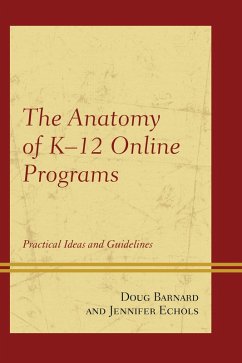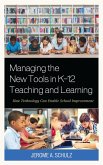Doug Barnard, Jennifer Echols
The Anatomy of K-12 Online Programs (eBook, PDF)
Practical Ideas and Guidelines
19,95 €
19,95 €
inkl. MwSt.
Sofort per Download lieferbar

10 °P sammeln
19,95 €
Als Download kaufen

19,95 €
inkl. MwSt.
Sofort per Download lieferbar

10 °P sammeln
Jetzt verschenken
Alle Infos zum eBook verschenken
19,95 €
inkl. MwSt.
Sofort per Download lieferbar
Alle Infos zum eBook verschenken

10 °P sammeln
Doug Barnard, Jennifer Echols
The Anatomy of K-12 Online Programs (eBook, PDF)
Practical Ideas and Guidelines
- Format: PDF
- Merkliste
- Auf die Merkliste
- Bewerten Bewerten
- Teilen
- Produkt teilen
- Produkterinnerung
- Produkterinnerung

Bitte loggen Sie sich zunächst in Ihr Kundenkonto ein oder registrieren Sie sich bei
bücher.de, um das eBook-Abo tolino select nutzen zu können.
Hier können Sie sich einloggen
Hier können Sie sich einloggen
Sie sind bereits eingeloggt. Klicken Sie auf 2. tolino select Abo, um fortzufahren.

Bitte loggen Sie sich zunächst in Ihr Kundenkonto ein oder registrieren Sie sich bei bücher.de, um das eBook-Abo tolino select nutzen zu können.
The growth of virtual online programs at the K-12 level is unparalleled in the history of education. This book discusses what constitutes a viable online program and how programs maintain rigorous courses, creditability, and high academic standards. Barnard and Echols provide practical information about the vision, curriculum, course designs, and the impact of "for profit" online schools. This book offers practical advice and guidance to those concerned with developing and improving current programs.
- Geräte: PC
- mit Kopierschutz
- eBook Hilfe
- Größe: 2.87MB
Andere Kunden interessierten sich auch für
![Managing the New Tools in K-12 Teaching and Learning (eBook, PDF) Managing the New Tools in K-12 Teaching and Learning (eBook, PDF)]() Jerome A. SchulzManaging the New Tools in K-12 Teaching and Learning (eBook, PDF)33,95 €
Jerome A. SchulzManaging the New Tools in K-12 Teaching and Learning (eBook, PDF)33,95 €![Undergraduate Curricular Peer Mentoring Programs (eBook, PDF) Undergraduate Curricular Peer Mentoring Programs (eBook, PDF)]() Undergraduate Curricular Peer Mentoring Programs (eBook, PDF)89,95 €
Undergraduate Curricular Peer Mentoring Programs (eBook, PDF)89,95 €![Building Successful Extracurricular Enrichment Programs (eBook, PDF) Building Successful Extracurricular Enrichment Programs (eBook, PDF)]() Michael CainBuilding Successful Extracurricular Enrichment Programs (eBook, PDF)25,95 €
Michael CainBuilding Successful Extracurricular Enrichment Programs (eBook, PDF)25,95 €![Cultivating Behavioral Change in K-12 Students (eBook, PDF) Cultivating Behavioral Change in K-12 Students (eBook, PDF)]() Marty HuittCultivating Behavioral Change in K-12 Students (eBook, PDF)28,95 €
Marty HuittCultivating Behavioral Change in K-12 Students (eBook, PDF)28,95 €![A Guide to Early College and Dual Enrollment Programs (eBook, PDF) A Guide to Early College and Dual Enrollment Programs (eBook, PDF)]() Russ OlwellA Guide to Early College and Dual Enrollment Programs (eBook, PDF)25,95 €
Russ OlwellA Guide to Early College and Dual Enrollment Programs (eBook, PDF)25,95 €![Students Taking Charge in Grades 6-12 (eBook, PDF) Students Taking Charge in Grades 6-12 (eBook, PDF)]() Nancy SullaStudents Taking Charge in Grades 6-12 (eBook, PDF)30,95 €
Nancy SullaStudents Taking Charge in Grades 6-12 (eBook, PDF)30,95 €![The Empower Program, K-2 (eBook, PDF) The Empower Program, K-2 (eBook, PDF)]() Rachel BakerThe Empower Program, K-2 (eBook, PDF)26,95 €
Rachel BakerThe Empower Program, K-2 (eBook, PDF)26,95 €-
-
-
The growth of virtual online programs at the K-12 level is unparalleled in the history of education. This book discusses what constitutes a viable online program and how programs maintain rigorous courses, creditability, and high academic standards. Barnard and Echols provide practical information about the vision, curriculum, course designs, and the impact of "for profit" online schools. This book offers practical advice and guidance to those concerned with developing and improving current programs.
Produktdetails
- Produktdetails
- Verlag: Bloomsbury eBooks US
- Seitenzahl: 100
- Erscheinungstermin: 17. November 2014
- Englisch
- ISBN-13: 9798216315865
- Artikelnr.: 74842884
- Verlag: Bloomsbury eBooks US
- Seitenzahl: 100
- Erscheinungstermin: 17. November 2014
- Englisch
- ISBN-13: 9798216315865
- Artikelnr.: 74842884
- Herstellerkennzeichnung Die Herstellerinformationen sind derzeit nicht verfügbar.
Doug Barnard is recognized as being the founder of K-12 online programs in Arizona. The Arizona Republic newspaper has referred to him as the Dean of online programs in Arizona. Over thirty other Arizona school districts have signed agreements to use the K-12 online program developed by Dr. Barnard and his staff.
Preface
Acknowledgments
Introduction
Chapter 1: The Current Online Environment
Increasing enrollment in K-12 online programs
Common myths about online learning
Essential program components
Challenges facing online programs
The oversight of online programs
The politics of online learning
Chapter 2: Starting an Online Program
Vision, mission, and core beliefs
Identify the Defining Attributes
Hire the Staff
Awareness of critics
Selection of technology/vendors
Chapter 3: Curriculum
Options for curriculum
Standards-based curriculum
Grade-level appropriate
Chunked curriculum and frequent feedback
Flexibility and accessibility
Differentiating instruction for diverse learners
Chapter 4: The Potential Impact of the Common Core
The core of the Common Core
High stakes tests
The Common Core drives changes
Alignment of Common Core standards in online programs
Implications for lesson design in online programs
Options for K-12 online programs
The bottom line - increased cost
Is the Common Core here to stay?
Chapter 5: Academic Integrity
What is academic integrity?
Academic integrity builds credibility
Shifting societal view of cheating
The politics of cheating
Leadership from the state
How easy it is to cheat?
Ensuring academic integrity
Consequences for cheating
Removing the incentive to cheat
Chapter 6: Evaluating Online Teachers and Specialists
Expectations for online teachers
Feedback is important
Can feedback change online teacher behavior?
Evaluation of program specialists
Chapter 7: Technology, Monitoring & Functions
LMS options
Monitoring expectations
Other functions of the LMS
Chapter 8: Future Trends & Issues
Development and management of online courses
Statewide policies
Planning for school closures
Appendix A
Acknowledgments
Introduction
Chapter 1: The Current Online Environment
Increasing enrollment in K-12 online programs
Common myths about online learning
Essential program components
Challenges facing online programs
The oversight of online programs
The politics of online learning
Chapter 2: Starting an Online Program
Vision, mission, and core beliefs
Identify the Defining Attributes
Hire the Staff
Awareness of critics
Selection of technology/vendors
Chapter 3: Curriculum
Options for curriculum
Standards-based curriculum
Grade-level appropriate
Chunked curriculum and frequent feedback
Flexibility and accessibility
Differentiating instruction for diverse learners
Chapter 4: The Potential Impact of the Common Core
The core of the Common Core
High stakes tests
The Common Core drives changes
Alignment of Common Core standards in online programs
Implications for lesson design in online programs
Options for K-12 online programs
The bottom line - increased cost
Is the Common Core here to stay?
Chapter 5: Academic Integrity
What is academic integrity?
Academic integrity builds credibility
Shifting societal view of cheating
The politics of cheating
Leadership from the state
How easy it is to cheat?
Ensuring academic integrity
Consequences for cheating
Removing the incentive to cheat
Chapter 6: Evaluating Online Teachers and Specialists
Expectations for online teachers
Feedback is important
Can feedback change online teacher behavior?
Evaluation of program specialists
Chapter 7: Technology, Monitoring & Functions
LMS options
Monitoring expectations
Other functions of the LMS
Chapter 8: Future Trends & Issues
Development and management of online courses
Statewide policies
Planning for school closures
Appendix A
Preface
Acknowledgments
Introduction
Chapter 1: The Current Online Environment
Increasing enrollment in K-12 online programs
Common myths about online learning
Essential program components
Challenges facing online programs
The oversight of online programs
The politics of online learning
Chapter 2: Starting an Online Program
Vision, mission, and core beliefs
Identify the Defining Attributes
Hire the Staff
Awareness of critics
Selection of technology/vendors
Chapter 3: Curriculum
Options for curriculum
Standards-based curriculum
Grade-level appropriate
Chunked curriculum and frequent feedback
Flexibility and accessibility
Differentiating instruction for diverse learners
Chapter 4: The Potential Impact of the Common Core
The core of the Common Core
High stakes tests
The Common Core drives changes
Alignment of Common Core standards in online programs
Implications for lesson design in online programs
Options for K-12 online programs
The bottom line - increased cost
Is the Common Core here to stay?
Chapter 5: Academic Integrity
What is academic integrity?
Academic integrity builds credibility
Shifting societal view of cheating
The politics of cheating
Leadership from the state
How easy it is to cheat?
Ensuring academic integrity
Consequences for cheating
Removing the incentive to cheat
Chapter 6: Evaluating Online Teachers and Specialists
Expectations for online teachers
Feedback is important
Can feedback change online teacher behavior?
Evaluation of program specialists
Chapter 7: Technology, Monitoring & Functions
LMS options
Monitoring expectations
Other functions of the LMS
Chapter 8: Future Trends & Issues
Development and management of online courses
Statewide policies
Planning for school closures
Appendix A
Acknowledgments
Introduction
Chapter 1: The Current Online Environment
Increasing enrollment in K-12 online programs
Common myths about online learning
Essential program components
Challenges facing online programs
The oversight of online programs
The politics of online learning
Chapter 2: Starting an Online Program
Vision, mission, and core beliefs
Identify the Defining Attributes
Hire the Staff
Awareness of critics
Selection of technology/vendors
Chapter 3: Curriculum
Options for curriculum
Standards-based curriculum
Grade-level appropriate
Chunked curriculum and frequent feedback
Flexibility and accessibility
Differentiating instruction for diverse learners
Chapter 4: The Potential Impact of the Common Core
The core of the Common Core
High stakes tests
The Common Core drives changes
Alignment of Common Core standards in online programs
Implications for lesson design in online programs
Options for K-12 online programs
The bottom line - increased cost
Is the Common Core here to stay?
Chapter 5: Academic Integrity
What is academic integrity?
Academic integrity builds credibility
Shifting societal view of cheating
The politics of cheating
Leadership from the state
How easy it is to cheat?
Ensuring academic integrity
Consequences for cheating
Removing the incentive to cheat
Chapter 6: Evaluating Online Teachers and Specialists
Expectations for online teachers
Feedback is important
Can feedback change online teacher behavior?
Evaluation of program specialists
Chapter 7: Technology, Monitoring & Functions
LMS options
Monitoring expectations
Other functions of the LMS
Chapter 8: Future Trends & Issues
Development and management of online courses
Statewide policies
Planning for school closures
Appendix A







